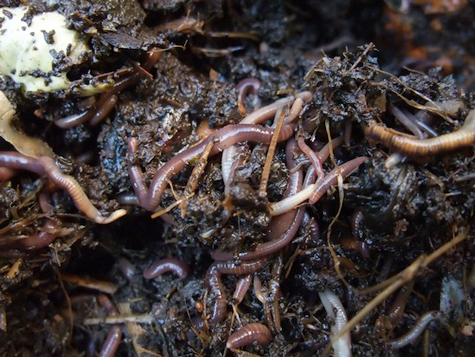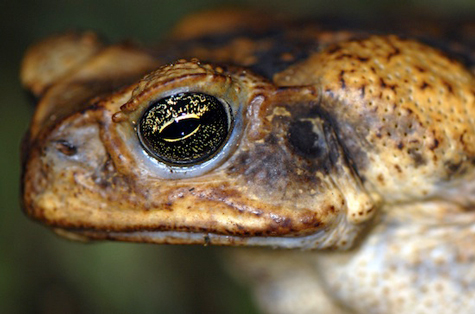The invaders do to change the world
Invasive alien organisms are highly adaptable, well-developed and fast-growing organisms. They compete with food, water and air . preventing the development of other organisms living in the same environment, changing the environment. The appearance of an alien creature can permanently alter or destroy native flora and fauna. Natural development history has recorded invasions that have permanently changed the surface of our planet.
The invading animals change the earth
Worm

This slippery little animal looks extremely trivial to you, but in the history of nature's development on earth it plays the most important role among invading species . Charles Darwin views earthworms as the most influential organism on the planet's ecosystems .
Earthworms land on the land after evolving from seaworms, from where they work hard to make soil loose and fertile. Where there is the presence of earthworms, there is a good crop; In other words, people rely on earthworms to prosper, and if earthworms disappear, the society there also declines.
Sugar cane

This toad was imported from Hawaii to Australia in 1935 to destroy beetles that spread across sugarcane fields. However, because the skin contains many toxins, sugarcane toad can kill larger animals , such as chickens, dogs, cats, snakes, lizards and even some frogs, when exposed to toxins on the skin. they significantly reduce the number of these species, seriously affecting biodiversity where they occur.
Currently, sugarcane toad is considered one of the most harmful organisms in Australia. The government is implementing a plan to last up to 15 years and spend $ 7 million to curb the development of these ' troubled guests '.
Zebra mussels

For the first time, zebra mussels were discovered in the St. River branch . Clair in the spring of 1988, but soon they were present in the Five Lakes, the Mississippi River and many Lakes in Central and Western America as well as in Canada. The zebra mussel was brought to the Black Sea and the Caspian Sea of Europe by transatlantic cargo ships.
The sailors brought them to make food; when some of these ships were wrecked, it gave them the opportunity to escape and multiply very quickly. Some of them came to the Five Lakes by clinging to the roars of cargo ships.
The presence of this mussel makes other indigenous species such as salmon, shrimp, and other aquatic species miserable because the food source is depleted . If the zebrafish continues to expand as it is now, soon the species in these lakes will be destroyed.
This small creature has made the US plan to last up to 10 years and cost up to $ 5 billion to destroy them.
Mouse

This rodent is a professional smuggler. Since the beginning of transport, they have been hiding on wagons or ships and hitchhiking from one place to another. Wherever they come, the ecosystem there is changed in a bad way .
When they first appeared on Macquarie Island, all attempts to repel their spread did not yield results and even made the situation worse, such as measures to enter cats to Mouse kill. These cats, along with rabbits, were brought here to make food, became extinct 2 bird breeds and depleted the native flora here.
It has been estimated that the total cost to overcome the degradation of the ecosystem here is up to 16 million USD.
Gypsy moths

The gypsy moth was brought to the United States by the French scientist Leopold Trouvelot in 1868 with the aim of breeding this worm with a native silkworm to create a new variety with higher disease resistance. However, after a few butterflies escaped from his lab, they found an ideal habitat and began to reproduce constantly.
Gypsy moths are long-haired species with vivid colors. With a growing number of them, they kill many trees by clearing the leaves of these trees, causing serious damage to the forests, affecting the wildlife system here.
Currently the gypsy moth is one of the most harmful to the most notorious woody plants in the eastern United States.
Starling birds

According to the US Department of Agriculture (USDA) document, starlings are brought from the United States to Europe as part of the ambition of bringing all the birds that appeared in Shakespeare's works to the United States. However, this plan of Shakespeare fans soon turned into a threat to the country's agriculture.
From a small number of individuals raised in New York in the 1800s, the population of this bird has now exploded and spread disease to other animals , causing a loss of about $ 800 million for agriculture. each year. Shakespeare probably never knew his ' muse ' was such a terror to posterity.
Kudzu

Cassava was brought from Japan to the United States in 1876 for planting as animal feed and to prevent soil erosion. However, the plant later became an ecological hazard in these areas because of its rapid development beyond its control .
This vines quickly spread everywhere, covering much of the cultivated area, killing many other native plants. Currently, cassava has grown extensively throughout the southeastern United States, rooted on a land area of about 20,000-30,000 km² and damaged about $ 500 million per year due to the area of cultivated land under this plant. cover and costs to control it.
Brown snake

In the 1950s, this snake was accidentally imported into Guam (an island in the Pacific Ocean); It is thought that they came here by ' taking a ride ' on cargo ships to the island. They are bulky with abundant food in the locality and there are very few competing competitors. Therefore, the population of this species has never stopped increasing, covering the whole island which was originally devoid of snakes.
They hunt almost exhausted or even extinct animals in native forests. With more than 13,000 individuals everywhere on the island, they attack people's homes, endangering young children and causing horrors for adults. They are also the culprits that cause power outages that affect the activities of life, commerce and the military in the area.
Pine bugs

The beetle that destroyed this pine has destroyed a huge area of forest. From Colorado to Washington state, annual outbreaks kill 2.6 million hectares of forest. In the north of the country, the situation is even worse when the beetle clouds destroyed 14 million hectares. The female beetles pierced the tree and laid eggs in the tunnels they dug in the trunk.
The hatched larvae continue to dig in the body, cutting off the nutrient pathway of the plant and killing the tree. In addition, they threaten grizzly bears because they eat white pine pines - the bear's main food source before entering the hibernation season.
Human

The worst invasive species among invasive species is human. Since ancient times, we have migrated from one place to another, seriously altering the real / animal populations wherever we set foot; threatens the survival of the species and changes the environment in which we come.
Our large migration and historical events have changed the natural world, affecting trees, animals, water, soil and even the atmosphere. And in fact, most of the animals / plants listed in this list are for us humans to become abusers .
- Why did the Vietnamese defeat the powerful army of Qin Shihuang?
- American sex hormones use fish trap blood
- Marching for climate change around the world
- Change the world with ... 5 USD
- Climate change affects 10% of the world population
- Imagination can change what we hear and see
- The tragedy of climate change
- The plains in the world are under threat
- The United States announced its anti-climate change program
- Challenges of global hot air
- Climate change threatens the world economy
- 'Prophecy' plans to change the world in 2050
 Why do potatoes have eyes?
Why do potatoes have eyes? 'Tragedy' the world's largest carnivorous life: Death becomes ... public toilet
'Tragedy' the world's largest carnivorous life: Death becomes ... public toilet Tomatoes were once considered 'poisonous' for 200 years
Tomatoes were once considered 'poisonous' for 200 years Detecting microscopic parasites on human face
Detecting microscopic parasites on human face